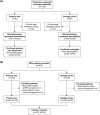Real-world assessment and characteristics of men with benign prostatic hyperplasia (BPH) in primary care and urology clinics in Spain
- PMID: 32609933
- PMCID: PMC7685138
- DOI: 10.1111/ijcp.13602
Real-world assessment and characteristics of men with benign prostatic hyperplasia (BPH) in primary care and urology clinics in Spain
Abstract
Objectives: To describe the real-world demographic and clinical characteristics of patients with lower urinary tract symptoms (LUTS) as a result of benign prostatic hyperplasia (BPH) in Spain.
Methodology: This observational, retrospective, multicentre study conducted in primary care and urology clinics in Spain included men aged ≥50 years diagnosed (≤8 years prior to study visit) with LUTS caused by BPH. The primary endpoint was demographic and clinical characteristics; secondary endpoints included disease progression and diagnostic tests across both healthcare settings.
Results: A total of 670 patients were included (primary care: n = 435; urology: n = 235). Most patients had moderate/severe LUTS (74.6%) and prostate volume >30 cc (81.7%), with no differences between settings. More patients had prostate-specific antigen (PSA) ≥1.5 ng/mL in primary care (74.5%) versus urology (67.7%). Progression criteria were prevalent (48.9%). Clinical criteria were more commonly used than the International Prostate Symptom Score (IPSS) to evaluate LUTS at diagnosis (primary care: clinical criteria 73.0%; IPSS: 26.9%; urology: clinical criteria 76.5%; IPSS: 23.4%). Proportion of patients with moderate/severe LUTS at diagnosis was lower using clinical criteria than IPSS, and the proportion of patients with 'worsening' LUTS (diagnosis to study visit) was higher when using clinical criteria versus IPSS. In both healthcare settings, the most commonly used diagnostic tests were general and urological clinical history and PSA.
Conclusion: Demographic and clinical characteristics of patients with BPH in Spain were similar in primary care and urology; however, assessment criteria to evaluate LUTS severity differ and are not completely aligned with clinical guideline recommendations. Increased use of recommended assessments may enhance optimal BPH management.
© 2020 The Authors. International Journal of Clinical Practice Published by John Wiley & Sons Ltd.
Conflict of interest statement
JMM has received financial compensation from GSK for scientific advice on the design and development of the study protocol and from IQVIA for participating as a researcher. JMM has also participated in: advisory boards for GSK and Astellas; speaker's bureaus for GSK, Astellas and Pierre Fabre and has received compensation from GSK and Pierre Fabre for being a trial investigator. BM has participated in advisory boards and speaker's bureaus and has received compensation for travel expenses and for being a trial investigator from GSK, Janssen, Astellas, Werfen, Bayer, Sanofi and IPSEN. JMP‐M, DLM, AAR and RCP are employees of GSK and hold shareholder status in the company. MTM‐F has received compensation from GSK for travel expenses and for being a trial investigator. AC is an employee of IQVIA.
Figures


Similar articles
-
Real-world therapeutic management and evolution of patients with benign prostatic hyperplasia in primary care and urology in Spain.Int J Clin Pract. 2021 Aug;75(8):e14250. doi: 10.1111/ijcp.14250. Epub 2021 May 29. Int J Clin Pract. 2021. PMID: 33884719 Free PMC article.
-
Construct validation of patient global impression of severity (PGI-S) and improvement (PGI-I) questionnaires in the treatment of men with lower urinary tract symptoms secondary to benign prostatic hyperplasia.BMC Urol. 2012 Nov 7;12:30. doi: 10.1186/1471-2490-12-30. BMC Urol. 2012. PMID: 23134716 Free PMC article.
-
Impact of metabolic syndrome-related factors on the development of benign prostatic hyperplasia and lower urinary tract symptoms in Asian population.Medicine (Baltimore). 2019 Oct;98(42):e17635. doi: 10.1097/MD.0000000000017635. Medicine (Baltimore). 2019. PMID: 31626149 Free PMC article.
-
EAU Guidelines on the Assessment of Non-neurogenic Male Lower Urinary Tract Symptoms including Benign Prostatic Obstruction.Eur Urol. 2015 Jun;67(6):1099-1109. doi: 10.1016/j.eururo.2014.12.038. Epub 2015 Jan 19. Eur Urol. 2015. PMID: 25613154 Review.
-
Phosphodiesterase inhibitors for lower urinary tract symptoms consistent with benign prostatic hyperplasia.BJU Int. 2019 Jul;124(1):27-34. doi: 10.1111/bju.14689. Epub 2019 Mar 11. BJU Int. 2019. PMID: 30681264
Cited by
-
A real-world evidence study of interhospital variability in the surgical treatment of patients with benign prostatic hyperplasia: the REVALURO study.Int Urol Nephrol. 2025 Mar;57(3):775-784. doi: 10.1007/s11255-024-04239-7. Epub 2024 Oct 29. Int Urol Nephrol. 2025. PMID: 39470938 Free PMC article.
-
Real-world therapeutic management and evolution of patients with benign prostatic hyperplasia in primary care and urology in Spain.Int J Clin Pract. 2021 Aug;75(8):e14250. doi: 10.1111/ijcp.14250. Epub 2021 May 29. Int J Clin Pract. 2021. PMID: 33884719 Free PMC article.
References
-
- Minana B, Rodriguez‐Antolin A, Prieto M, Pedrosa E. Severity profiles in patients diagnosed of benign prostatic hyperplasia in Spain. Actas Urol Esp. 2013;37:544‐548. - PubMed
-
- Speakman MJ. Lower urinary tract symptoms suggestive of benign prostatic hyperplasia (LUTS/BPH): more than treating symptoms? Eur Urol Suppl. 2008;7:680‐689.
-
- Boyle P, et al. The relationship between lower urinary tract symptoms and health status: the UREPIK study. BJU Int. 2003;92:575‐580. - PubMed
-
- Hakimi Z, Herdman M, Pavesi M, et al. Using EQ‐5D‐3L and OAB‐5D to assess changes in the health‐related quality of life of men with lower urinary tract symptoms associated with benign prostatic hyperplasia. Qual Life Res. 2017;26:1187‐1195. - PubMed
Publication types
MeSH terms
Grants and funding
LinkOut - more resources
Full Text Sources
Medical
Research Materials
Miscellaneous
